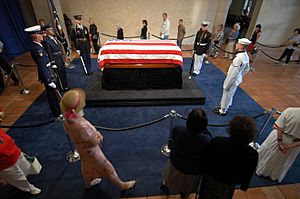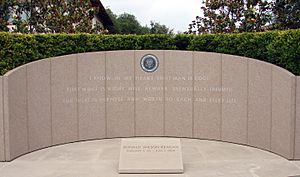Ronald Reagan Presidential Library and Museum facts for kids
Quick facts for kids Ronald Reagan Presidential Library |
|
|---|---|
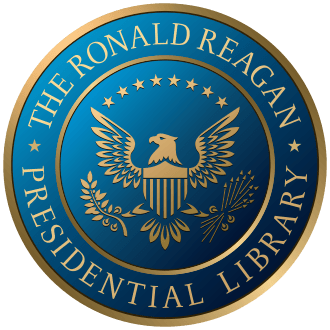 |
|
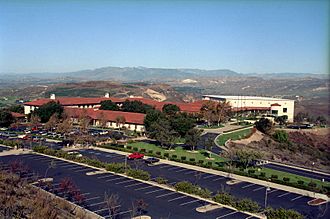 |
|
| General information | |
| Location | Simi Valley, California, United States |
| Coordinates | 34°15′34″N 118°49′10″W / 34.2595°N 118.8194°W |
| Named for | Ronald Reagan |
| Construction started | November 21, 1988 |
| Completed | November 4, 1991 |
| Management | National Archives and Records Administration Reagan Library Foundation |
| Technical details | |
| Size | 243,000 square feet (22,600 m2) |
| Design and construction | |
| Architect | Hugh Stubbins |
The Ronald Reagan Presidential Library is a special place that holds all the official papers and items from when Ronald Reagan was the 40th President of the United States. It is also where President Reagan and his wife, Nancy Reagan, are buried. This library is the biggest of the 13 presidential libraries run by the government. It has millions of documents, photos, films, and audio recordings.
You can visit the library to see a permanent exhibit about President Reagan's life. There are also cool items like Air Force One, which was the plane the president used to travel. You can even see a piece of the Berlin Wall! The library is located in Simi Valley, California, in Southern California. It was designed by a person named Hugh Stubbins. The National Archives and Records Administration (NARA) helps manage it.
Contents
Building the Reagan Library
The idea for the Reagan Library started in 1981. W. Glenn Campbell, who led the Hoover Institution, suggested building it at Stanford University. President Reagan liked this idea because he had already kept some of his papers there from when he was governor of California.
However, there were some disagreements about having the library at Stanford. Some people worried it would be too political. Because of these concerns, the plans for the library at Stanford were canceled in 1987. That same year, the location in Simi Valley, California was chosen instead.
Designing the Library's Look
The library was designed by Hugh Stubbins and Associates. It is about 40 miles (64 km) northwest of Downtown Los Angeles. Construction began in 1988. The library officially opened on November 4, 1991.
At its opening, it was the largest presidential library. The opening ceremony was a big event. It was the first time in U.S. history that five U.S. Presidents were together in one place: Richard Nixon, Gerald Ford, Jimmy Carter, Ronald Reagan, and George H. W. Bush. Six First Ladies also attended.
What You Can Find Inside
The Reagan Library is a place where many important records from President Reagan's time in office are kept. It has about 50 million pages of documents, over 1.6 million photos, and thousands of films and tapes. It also holds papers from his eight years as Governor of California.
When it first opened, the library was about 153,000 square feet (14,200 m2). It was the largest presidential library until the Clinton Presidential Center opened in 2004. But then, in 2005, the Air Force One Pavilion was added. This made the Reagan Library the largest again in terms of physical size. The library was built using only private donations, costing about $60 million.
In 2019, the library was almost surrounded by the Easy Fire. Luckily, goats had cleared the brush around the buildings earlier that year. This helped save the library from burning down.
Exploring the Exhibits
The museum at the Reagan Library has both temporary exhibits and a permanent one about President Reagan's life. This exhibit starts with his childhood in Dixon, Illinois. It then covers his time as a film actor and his military service. You can also learn about his marriage to Nancy Davis Reagan and his political career.
Governor and President Exhibits
The "Citizen Governor" area shows videos of Reagan's 1964 speech, "A Time for Choosing." It also has displays about his eight years as governor. You can see a 1965 Ford Mustang that Reagan used during his first campaign for governor. His desk from when he was governor is also there.
The museum highlights his 1980 and 1984 presidential campaigns. You can see his inauguration suit and a table from the White House Situation Room. There is also information about the 1981 attempt on his life and his idea for the Strategic Defense Initiative (SDI), also called "Star Wars."
Oval Office and Other Displays
A full-size copy of the Oval Office is a popular part of the museum. This is a common feature in most presidential libraries. You can see items like a copy of a bronze statue that Reagan kept on his desk. Other parts of the exhibit focus on Reagan's ranch, the presidential retreat Camp David, and life in the White House. There's also a section about Nancy Reagan, the First Lady.
The outdoor grounds offer great views of the area. There is a re-creation of part of the White House Lawn. You can also see a large piece of the Berlin Wall. An F-14 Tomcat jet is also on display outside. In 2016, a large statue of President Reagan riding his favorite horse, El Alamein, was placed in front of the Air Force One Pavilion.
Air Force One Pavilion
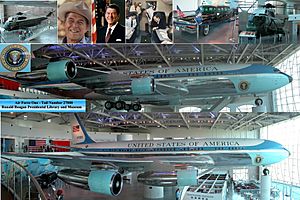
A large exhibit hangar, about 90,000 square feet (8,400 m2), houses the actual Boeing 707 aircraft that served as Air Force One during Reagan's presidency. This plane, called SAM 27000, was used by seven presidents from 1973 to 2001. This includes Richard Nixon, Gerald Ford, Jimmy Carter, George H.W. Bush, Bill Clinton, and George W. Bush.
In 2001, the plane was taken apart and moved to the library in pieces. Then, it was put back together and restored to look like it did when it was in service. The pavilion opened on October 24, 2005.
Presidential Travel Exhibits
SAM 27000 is part of a larger exhibit about how presidents travel. This includes a Sikorsky VH-3 Sea King helicopter, known as Marine One, from the Lyndon B. Johnson era. You can also see a presidential motorcade. This includes Reagan's 1984 presidential limousine, a 1982 Los Angeles Police Department police car, and two 1980s police motorcycles. A 1986 Secret Service vehicle is also on display.
The pavilion also has the original O'Farrell's pub from Ballyporeen, Republic of Ireland. President and Mrs. Reagan visited this pub in 1984. It is now called the "Ronald Reagan Pub." There are also exhibits about the Cold War and Reagan's many trips on Air Force One.
In 2008, the Reagan Library Discovery Center opened in the Air Force One Pavilion. This is an interactive exhibit for students in fifth through eighth grades. They can take part in role-playing games based on events from the Reagan administration.
Events and Debates
The Reagan Library has hosted many important events. These include the funeral of Ronald Reagan in June 2004. It has also been the location for several Republican presidential candidate debates.
Republican Debates at the Library
On May 3, 2007, the Reagan Foundation and Nancy Reagan hosted the first Republican primary debate for the 2008 election. Many candidates were there, including Rudy Giuliani, John McCain, and Mitt Romney.
The library hosted the final Republican debate for the 2008 election on January 30, 2008. It also hosted the first Republican primary debate for the 2012 election on September 7, 2011. In September 2015, the library was the site of the second Republican presidential debate for the 2015-2016 election cycle.
Centennial Celebration and Renovation
The Ronald Reagan Presidential Foundation and General Electric (GE) worked together to celebrate President Reagan's 100th birthday on February 6, 2011. GE was a major sponsor of this event. Reagan had hosted the General Electric Theater and was an ambassador for GE from 1954 to 1962.
GE helped by giving $10 million to support the celebration. This money also helped create a new, modern museum at the Reagan Library. A new General Electric Theater was added, focusing on Reagan's career in radio, television, and film. GE also gave $5 million to start the GE–Reagan Scholars Program. This program gives college scholarships to students who show the values that President Reagan stood for.
GE also donated 208 restored episodes of the General Electric Theater. Many of these episodes were thought to be lost or damaged. They were found and fixed to be shown in the renovated museum.
Ronald Reagan's Final Resting Place
After President Reagan passed away on June 5, 2004, his casket was brought to the Reagan Library on June 7. Many people lined the streets to pay their respects. A memorial service was held in the library lobby for his family and close friends.
From June 7 to 9, Reagan's casket was in the library lobby. About 105,000 people came to see it and say goodbye. After services in Washington, D.C., Reagan's casket was brought back to the library in California for his final burial.
The library was designed to include a tomb for both President Reagan and his wife. On the morning of June 12, 2004, Reagan was laid to rest in the underground vault.
On March 6, 2016, Nancy Reagan passed away at the age of 94. She was buried next to her husband at the library on March 11, 2016.
Images for kids
See also
 In Spanish: Biblioteca y Museo Presidencial de Ronald Reagan para niños
In Spanish: Biblioteca y Museo Presidencial de Ronald Reagan para niños


